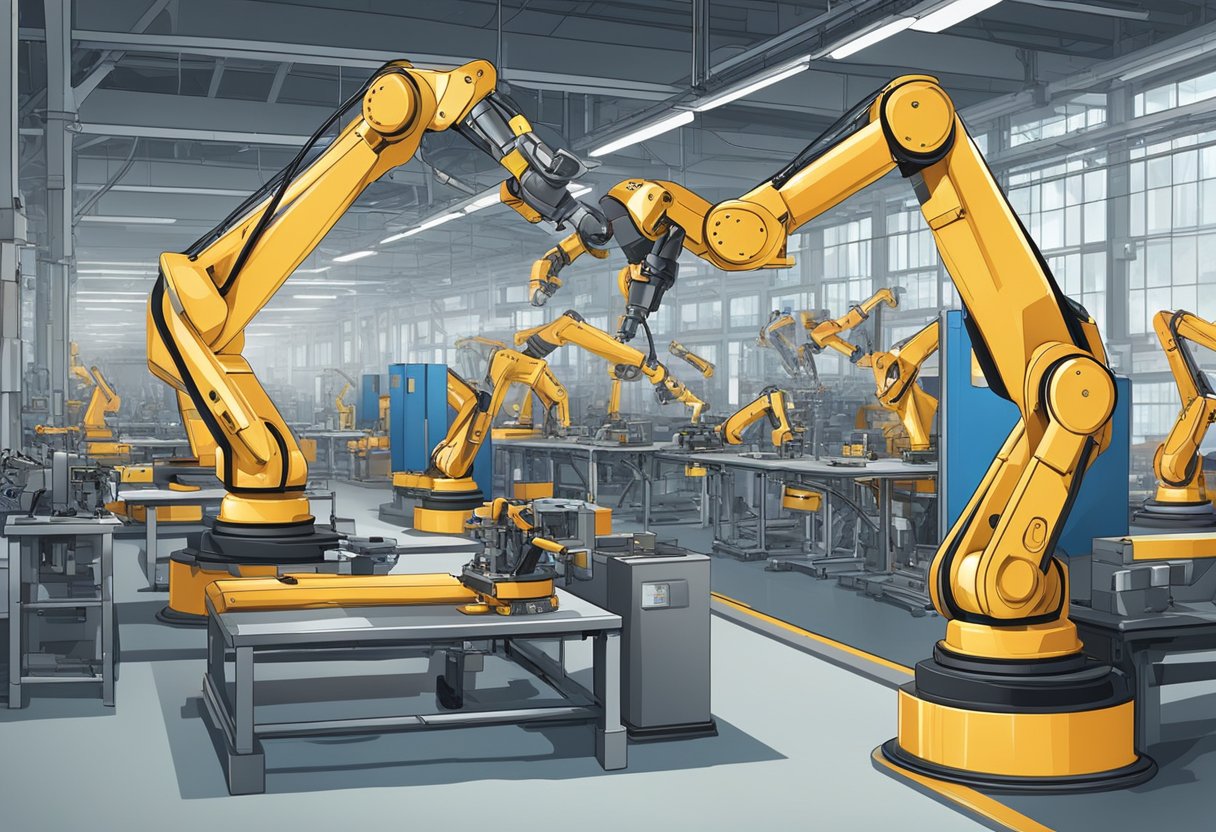The Impact of AI on Jobs: Shaping the Future Workforce
The rise of artificial intelligence is reshaping the job landscape in profound ways. As AI technology advances, it changes the nature of work and which roles are essential. The impact of AI on jobs can be seen through both the loss of certain positions and the creation of new opportunities that require different skill sets.

Many industries are adapting to incorporate AI tools, which leads to efficiency improvements but also raises concerns about job displacement. Workers in roles like manufacturing may face significant changes, with millions expected to transition by 2025 as their tasks are automated. Nevertheless, this transformation also opens doors for new career paths in tech and data analysis for those willing to adapt.
Understanding how AI interacts with the workforce becomes crucial for employees and employers alike. Observing these shifts allows individuals to prepare for the jobs of tomorrow while ensuring that the benefits of AI are shared across society.
Key Takeaways
- AI technology is transforming both job roles and entire industries.
- There is a growing need for new skill development to meet the demands of the AI-driven job market.
- The balance between innovation and job security is a critical discussion in the future of work.
Historical Context and Evolution of AI
The development of artificial intelligence has a rich history that spans many decades. From its early concepts to recent advancements, AI has shaped how industries operate and affected jobs in many ways.
Early Developments in AI
AI’s journey began in the 1950s when researchers aimed to create machines that could mimic human thought. Early efforts included simple programs that could solve math problems and play games like chess. Pioneers like Alan Turing laid the groundwork with the Turing Test, a measure of a machine’s ability to exhibit intelligent behavior.
During this time, many believed that machines would soon think like humans. However, progress slowed due to technological limitations and a lack of understanding of complex human cognition. This period, known as the “AI winter,” saw decreased funding and interest in AI research.
The Technological Revolution and AI
The 1990s brought a technological revolution that reignited interest in AI. The rise of personal computers and the internet enabled more data to be processed. This led to the development of more sophisticated algorithms and machine learning techniques.
AI tools began to enter various industries, improving efficiency and decision-making. Businesses adopted AI for tasks like data analysis, customer service, and logistics. These applications demonstrated AI’s potential to transform workflows and reduce human effort in repetitive tasks.
Generative AI and Modern Advancements
In recent years, generative AI has emerged as a powerful force, enabling machines to create new content. Models like ChatGPT have captivated users by generating human-like text based on prompts. This represents a leap forward in natural language processing and user interaction.
Modern advancements in AI are reshaping work environments. Companies now use AI tools to automate tasks and enhance creativity. Generative AI raises important questions about the future of work and how it will impact employment roles and job structures. As these technologies evolve, their influence on jobs will continue to grow.
AI’s Impact on Employment and the Economy
Artificial intelligence is reshaping employment patterns and economic dynamics. Its influence spans labor demand, productivity, wages, and the structure of skilled and unskilled job markets. Understanding these aspects will highlight the broader implications of AI in society.
Shifts in Labor Demand and Workforce Dynamics
AI changes labor demand across industries. Many routine tasks are automated, leading to decreased demand for certain jobs, particularly in manufacturing and data entry. Yet, this shift creates new opportunities in tech and engineering, where skilled workers are needed to develop and maintain AI systems.
Examples of affected sectors include:
- Manufacturing: Routine assembly jobs decline.
- Tech: Increased demand for AI specialists and data scientists.
This change requires workers to adapt. Retraining programs are critical to help employees transition into new roles that leverage AI technology.
The Role of AI in Job Growth and Productivity
AI can boost productivity significantly. By automating repetitive tasks, firms can focus on higher-value activities. This has the potential to create new jobs, even as some are lost.
Consider the following benefits:
- Efficiency: Companies can produce more with fewer resources.
- Innovation: New products and services emerge from AI advancements.
The positive impact on productivity can lead to job creation in sectors that benefit from these efficiencies. Industries like healthcare and finance are experiencing growth due to AI applications.
Understanding Wages and Income Inequality
AI’s effects on wages are complex. While it can increase productivity, the benefits may not be equally distributed. Higher-skilled workers often see wage increases, while low-skilled positions may face stagnant or declining wages.
Key factors influencing wages:
- Skill Level: Those with advanced skills see better compensation.
- Job Type: Routine jobs are more susceptible to wage declines.
Income inequality may widen as disparities emerge between skilled and unskilled labor. This phenomenon necessitates a focus on education and training to provide equitable opportunities.
AI’s Effect on Skilled and Unskilled Jobs
AI’s influence on job types differs. Skilled jobs, particularly in tech, are growing. These positions often require specialized training and offer higher wages.
On the other hand, unskilled jobs are under threat. Jobs in sectors like retail and administrative support face higher risks of automation. This shift impacts employment levels and requires strategies for workforce development.
Key observations include:
- Skilled jobs are on the rise, needing more training.
- Unskilled positions may decline sharply, prompting potential unemployment.
Addressing the gap in opportunities is critical for a balanced labor market as AI continues to evolve.
Sector-Specific Transformations Due to AI
AI is reshaping many sectors by introducing automation and improving efficiency. Different industries are experiencing unique transformations, particularly in manufacturing, healthcare, e-commerce, creative fields, and information technology.
Industrial Automation and Manufacturing
AI technologies, including industrial robots, enhance productivity and worker safety in manufacturing. These systems automate repetitive tasks, reducing human error and increasing precision.
For example, AI-driven predictive maintenance helps prevent machine failures, resulting in less downtime. Companies that adopt automation often report a positive impact on their employment share, as AI can create new roles focused on oversight and maintenance of these technologies.
While some jobs may be replaced, many factories embrace a new model that combines AI and human skills. Workers trained alongside robot systems can manage operations more effectively.
AI in Healthcare and Life Sciences
In healthcare, AI is transforming diagnostics, treatment plans, and patient management. Algorithms analyze vast amounts of medical data, leading to faster and more accurate diagnoses.
For instance, machine learning can identify patterns in medical scans, improving cancer detection rates. AI tools also assist healthcare providers in personalizing treatment plans tailored to individual patients’ needs.
Additionally, AI enhances patient engagement through chatbots and virtual assistants, which provide 24/7 support. This shift helps healthcare professionals focus more on complex cases, ultimately improving patient outcomes.
Digital Economy and E-Commerce
E-commerce is leveraging AI for better customer experiences and operational efficiency. AI algorithms personalize shopping experiences by analyzing user data and recommendations.
Key applications include:
- Chatbots for customer service.
- Inventory management systems that predict demand.
- Dynamic pricing models based on market trends.
These advancements allow e-commerce companies to reduce costs and respond quickly to customer needs. In many cases, this leads to job creation in areas such as logistics and tech support, where human oversight remains essential.
AI Adoption in Creative Industries
Creative industries are also experiencing AI transformations. AI tools assist in content creation, from music to writing. For example, software can generate music or suggest plot ideas for stories.
The Writers Guild of America has raised concerns about the impact of AI on writers’ roles, fearing job displacement. Yet, many creatives find that AI can enhance their work, providing new ideas and speeding up some processes.
Collaborative efforts, such as partnerships with AI developers, help writers and artists use these tools while maintaining their creative identities.
AI in Information Technology and Software Development
In the realm of information technology, AI optimizes software development processes. Developers utilize AI to automate code generation, debugging, and testing. This transformation shortens development cycles and improves software quality.
Key benefits include:
- Increased efficiency through automation.
- Enhanced accuracy in code delivery.
- Reduction in repetitive tasks.
This shift allows IT professionals to focus on more strategic issues and innovations. As companies adapt to AI, they often seek skilled workers who can harness these technologies effectively, highlighting a growing demand for AI-savvy professionals in the tech field.
Social and Ethical Considerations of AI
The integration of artificial intelligence into various sectors raises significant social and ethical issues. These concerns are particularly relevant in the workplace, education, and issues of inequality in society. Understanding these can help in making informed decisions about AI’s role in daily life.
AI and Its Influence on Workplace Ethics
AI technologies change how decisions are made in the workplace. With recruitment algorithms, companies can screen candidates more efficiently. However, bias in these algorithms can lead to unfair hiring practices, affecting diversity.
Key ethical questions include:
- What criteria are used to make decisions?
- How transparent are these processes?
Employers must ensure that AI tools follow ethical standards. Developing clear policies can help prevent potential job losses or discrimination. It is vital to engage in continuous dialogue about these ethical implications.
AI and the Future of Education
In education, AI tools offer personalized learning experiences. They can adapt to each student’s pace and style, making education more effective. Yet, there are ethical concerns about data privacy and student surveillance.
Considerations include:
- How is student data collected and used?
- Are all students given equal access to these technologies?
Using AI responsibly can help enhance learning, but educators must address these ethical issues. Ensuring equitable access is essential for future generations.
Addressing Inequality and AI’s Impact on Society
The rise of AI can deepen existing inequalities. Workers in low-skill jobs are particularly vulnerable to job displacement. This creates a widening gap between those who can leverage technology and those who cannot.
Key measures to address inequality include:
- Training programs for displaced workers.
- Policies to promote fair access to AI tools.
Businesses and governments need to collaborate on solutions to mitigate negative impacts. Fostering inclusivity in AI development will ensure that benefits are shared more widely across society.
AI, Management, and Organizational Change
AI is changing how management operates within organizations. With AI tools, leaders can make better decisions, manage talent more effectively, and adapt to changing work environments. The influence of AI on knowledge workers and managers will shape their roles and responsibilities.
AI’s Role in Management Decisions
AI tools provide managers with data-driven insights that improve decision-making. By analyzing data, these tools help identify patterns and forecast outcomes. For example, AI can highlight employee performance trends, enabling managers to allocate resources more effectively.
Managers can use AI to streamline processes, such as recruitment and employee evaluations. This reduces bias and allows for a more objective assessment of candidates. Additionally, AI can enhance project management by predicting delays and resource needs.
Impact on Knowledge Workers and Managers
Knowledge workers are experiencing significant changes due to AI. These workers often rely on data for research, analysis, and reporting. AI tools can automate repetitive tasks, allowing them to focus on more strategic activities. This shift may lead to improved job satisfaction for some, as they engage in higher-level work.
For managers, the use of AI means reconsidering their roles. They must adapt to new tools and find ways to integrate them into daily operations. This includes fostering a culture of collaboration and continuous learning. Managers who embrace AI can enhance team productivity and drive organizational success. Balancing AI implementation with human skills will be crucial in this evolving landscape.
Predictions for the Future of Work
The future of work will be greatly influenced by AI technology, impacting job roles and workplace dynamics. As businesses adapt, there will be both challenges and opportunities that arise from these changes.
AI’s Continuing Role in Shaping the Future
AI technology is set to transform many aspects of work. Reports suggest that AI could replace up to 300 million full-time jobs globally by 2030. While this may seem alarming, it also opens the door for job creation. New roles will likely emerge in sectors that require digital literacy and AI management.
Key areas of impact include:
- Automation of Routine Tasks: Many repetitive jobs will be streamlined.
- Enhanced Productivity: AI can increase efficiency, allowing workers to focus on higher-value tasks.
To prepare for this shift, companies need to invest in digital infrastructure and training programs, helping workers adapt to their evolving roles as they navigate this new landscape.
Challenges and Opportunities Ahead
As AI technologies continue to advance, businesses and workers face several challenges. One major concern is the risk of unemployment in traditional roles. Workers may feel insecure about their jobs due to automation.
Opportunities include:
- New Job Creation: Predictions indicate that 69 million new jobs may arise by 2028.
- Upskilling: Workers can enhance their skills to meet new demands.
Adaptation is crucial. Companies must cultivate a culture of continuous learning to support their employees. Strategies should include partnerships with educational institutions to ensure workers are ready for the future job market.
Enhancing the Value of AI

AI has the potential to significantly boost business outcomes and productivity. By optimizing AI tools, improving data analysis, and evolving AI technology, organizations can enhance their operations and decision-making processes.
Optimizing AI for Business and Productivity
Optimizing AI involves aligning technology with business goals. Companies can focus on using AI tools that fit their specific needs. These tools, like chatbots for customer service or automated reporting systems, help streamline processes.
By implementing AI effectively, organizations report increased productivity. For instance, AI can automate repetitive tasks, freeing employees to tackle more complex problems. A well-optimized AI can lead to significant cost savings. It allows businesses to adapt quickly to market changes, making them more competitive.
Data Analysis and Decision-Making
AI greatly enhances data analysis, allowing companies to transform raw data into actionable insights. With powerful algorithms, AI can identify trends and patterns that may not be visible to human analysts.
These insights assist decision-makers in strategic planning. Businesses can make informed choices about product launches, marketing strategies, or operational improvements.
AI tools can also perform predictive analysis. This means they can forecast future trends based on historical data. By leveraging AI for data analysis, companies can increase their chances of success and minimize risks.
Evolving AI Technologies and Tools
AI technologies are continually evolving, creating new opportunities for businesses. Innovations such as machine learning and natural language processing are changing the landscape.
OpenAI is at the forefront of these advancements, providing powerful tools for various industries. Companies can now access advanced AI applications that enhance their capabilities.
As AI tools become more user-friendly, businesses of all sizes can implement them. This democratization of AI fosters creativity and innovation, enabling companies to solve problems in new ways. By staying updated on AI developments, organizations can harness new technologies to stay competitive.
Frequently Asked Questions

Artificial intelligence will bring significant changes to the job market. This includes the types of jobs that may disappear, new opportunities that may be created, and the skills needed for future work. Here are some common questions surrounding these topics.
How will artificial intelligence change the job market in various industries?
AI will change the job market by improving efficiency and automating tasks in many industries. For example, manufacturing may see more robots assembling products. In healthcare, AI can assist with patient diagnosis and treatment planning, allowing for faster and better care.
What types of jobs are at greatest risk of being replaced by AI technology?
Jobs that involve routine tasks are at high risk of being replaced by AI. This includes roles in data entry, retail checkouts, and certain aspects of customer service. These positions can be automated, making them less necessary in the future job market.
What new employment opportunities might arise from the advancement of AI?
The advancement of AI can lead to new roles focused on technology and management. Jobs in AI development, ethics, and oversight are likely to grow. Additionally, positions requiring creativity and emotional intelligence, like those in design and counseling, may also become more important.
In what ways can AI potentially boost productivity and economic growth?
AI can enhance productivity by performing tasks faster and with higher accuracy than humans. This can lower costs and increase output in sectors like agriculture, manufacturing, and services. As companies adopt AI, it can lead to significant economic growth in various sectors.
How might AI influence the skills required for future jobs?
AI will shift the skills needed in many jobs. There will be a greater demand for digital skills, data analysis, and problem-solving abilities. Soft skills like communication and teamwork will also be crucial as people work alongside AI systems.
How can workers prepare for the shift in the job market due to AI innovations?
Workers can prepare by focusing on lifelong learning and skills development. Engaging in training programs that enhance technical and soft skills will be beneficial. Flexibility and adaptability will be key traits for those navigating future job markets influenced by AI.






Post Comment